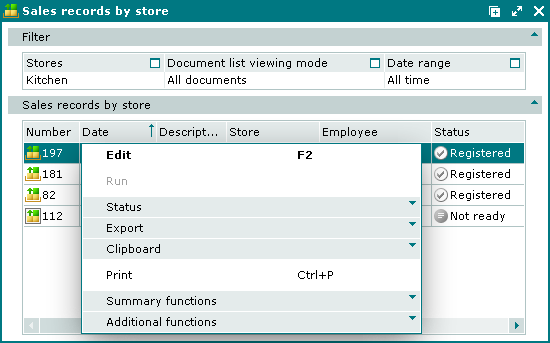© Tillypad 2008-2014
Sales records are used to describe the deduction of stock items as a result of the sale of menu items that belong to the Stock item class. For example, the deduction of 200 ml of the stock item Fresh carrot juice after selling 1 portion of the menu item Fresh carrot juice.
When a sales record is processed by the storekeeping system, the stock levels of those stock items which are associated with relevant menu items or ingredients of a recipe will be adjusted accordingly.
If a menu item is associated with a simple stock item, processing the sales record will simply adjust the quantity of this stock item. However, if the menu item is associated with a stock item with a recipe, the stock item concurrence will determine whether to adjust the quantity of the stock item itself or its ingredients.
The document list is used for viewing and managing sales records created for selected stores and date ranges.
Location: – – .
You can also open the list of sales records by using the command from the context menu of the directory.

Data grid columns:
Number indicates the number of the sales record. If the sales record store status is either Running or Execution error, an additional icon appears to the right of the record number.
Date denotes the date and time when the sales record was created.
Description is a short description of the sales record.
Store indicates the store in which the sales record was created.
Business day is the business day on which the stock items were sold.
Employee is the employee who opened the business day.
Division denotes the division where the business day was opened.
Total by cost price is the cost price of stock items in the sales record.
Status (overall) indicates the overall status of the sales record.
Status is the status of the sales record.
The user can assign one of the following statuses to the sales record:
Not ready – the record is open for changes. The document has either not yet been processed or has been processed, but the results were canceled.
Ready – the document cannot be edited. The document has not been processed.
Registered – the document is ready and has been processed. It cannot be edited.
Status (store) is the status assigned to the sales record after it has been processed by the storekeeping system. The sales record status in this column refers to the record processing status and can be one of the following:
OK – the document has been successfully processed.
Running – the document is being processed by the storekeeping system.
Execution error – an error occurred when the document was processed.
Editing document in a closed store period – this status appears when a document that belongs to a closed store period is processed.
System is a tag identifying system objects.
The context menu contains the following commands:
(F2) – edits existing sales records.
– processes sales records in the storekeeping system.
This command is only available for sales records with the Execution error status.
– menu with the commands to alter the document status.
When you select one or more documents with the same status, their current status will not be available in the context menu. When you select documents with different statuses, all possible statuses will be available in the context menu.
– menu with the commands to export files into an external file or update package.
– menu with the commands to operate the clipboard.
(Ctrl+P) – generates print layouts.
– menu with the commands to manage the summary functions of the data grid.
– menu with the commands to operate the data grid.
The and windows are used for editing entries in the document list.

